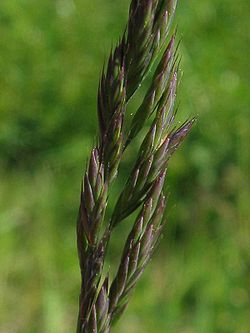| Festuca rubra | |
|---|---|
 | |
| Spikelets and flowers | |
| Scientific classification | |
| Kingdom: | Plantae |
| Clade: | Tracheophytes |
| Clade: | Angiosperms |
| Clade: | Monocots |
| Clade: | Commelinids |
| Order: | Poales |
| Family: | Poaceae |
| Subfamily: | Pooideae |
| Genus: | Festuca |
| Species: | F. rubra |
| Binomial name | |
| Festuca rubra | |
| Synonyms | |
| |
Festuca rubra is a species of grass known by the common name red fescue, [1] creeping red fescue or the rush-leaf fescue. It is widespread across much of the Northern Hemisphere and can tolerate many habitats and climates. It is best adapted to well-drained soils in cool, temperate climates; it prefers shadier areas and is often planted for its shade tolerance. [2] [3] Wild animals browse it, but it has not been important for domestic forage due to low productivity and palatability. [2] It is also an ornamental plant for gardens.


